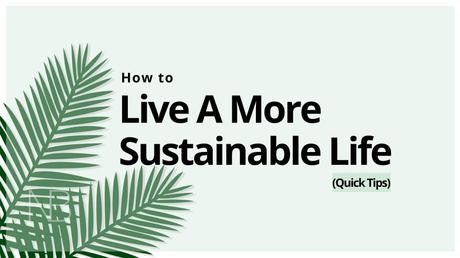
With every kilowatt of energy and every litre of water saved, you will feel good about making a tangible contribution to save our mother Earth.
Keeping the positive balance between the benefits provided to us by our planet and our investments in its future sustainability may be difficult at times. There are many things to learn if you want to become an environmentally responsible person while also making these activities a regular affair in your overall lifestyle.
Here are 10 quick (and proven) tips to be more sustainable at home and in your everyday life.
TL;DR
- Switch to LED lighting
- Replace plastic with stainless-steel
- Go paperless (as much as possible)
- Use rechargeable batteries
- Beware of commercial candles
- Track and smartly optimize your energy consumption
- Use better insulation
- Try a flexitarian diet (for once)
- Take a mindful approach to life
- Appreciate quality over quantity
Let's discuss these in details.
1. Go LED
This could be your first step towards a more sustainable lifestyle.
If you haven't already, replace all the lights in your house with quality LED lights.
Make sure that you try different versions of white before making the final change. We would advise using a warmer colour of 1800-2400K for relaxation and anywhere between 4000K to 6000K for productivity. You may also need to select the optimum wattage or install dimmers to avoid draining more power from your outlet than you actually require. Using LED strip lights only to highlight the zones you need may also be an excellent way to cut down your utility bills and make your home more sustainable.
Read more: Common mistakes to avoid when switching to LED lighting
2. Buy reusable containers
A high-quality stainless-steel water bottle or vacuum flask will easily pay for itself as you start taking your own homemade coffee to work.
It will also allow you to avoid buying overpriced plastic bottles of water when you are out and about. Even if you choose to get a Starbucks Iced White Chocolate Mocha from time to time, you can drink it from your own cup (and get a little discount in the process).
The same goes for high-quality PET and HDPE food containers that are BPA-free and labelled safe for food products. They will probably last you a lifetime and justify higher initial costs.
3. Go paperless (whenever you can)
Most people only use utility bills, mail notifications or thousands of other printed documents 1-2 times before throwing them in a garbage bin. Considering the costs of paper production and the number of trees cut down in the process, switching to electronic documents can be one of the most sustainable decisions you can ever make.
This also contributes to your cybersecurity since you stop throwing away printed papers containing potentially sensitive information.
4. Use rechargeable batteries
There is no real need to buy new packs of batteries for your electronic goods consistently.
Modern rechargeable alternatives have huge capacity and can be charged extremely fast. You can keep a spare set of traditional AAs or AAAs just in case, but really there is no reason not to use their cheaper and sustainable replacements. Make sure that you fully understand the instructions when you need to dispose of them since some batteries contain cadmium, lead, and other environmentally unsafe materials.
5. Beware of commercial candles
You may not know it, but most decorative candles found at your nearest supermarket are manufactured from petroleum in the process of crude oil refinement. Burning them at home may lead to the emission of toluene and other potentially toxic compounds.
While avoiding the use of petroleum in your car may be difficult, it is easy to switch to Beeswax candles and similar eco-friendly alternatives for most of your indoor needs.
6. Track and optimize your energy consumption
From the long-term perspective, purchasing white goods with an energy efficiency of A+ or higher can substantially reduce your utility bills and your carbon footprint.
You may also choose to experiment with smart power strips, programmable thermostats, and other advanced solutions to better understand the largest energy drain sources in your house and minimize this waste. Using smart plugs that calculate your power consumption may be a good way to see how much power individual appliances consume during their use.
Many electronic devices are hidden 'energy vampires' that may use energy even in standby mode. Using timer-based outlets for charging your smartphone or tablet can also increase its service life due to the prevention of overcharging.
7. Use 'proper' insulation
If you are planning to perform some home renovation in the near future, make sure to get your house or apartment walls properly insulated.
Even the simplest materials will radically reduce heat loss in winter while also keeping your rooms cooler in summer. Hence, you will spend much less on air-conditioning or heating throughout the year. If you invest a little more into high-density mineral wool materials, you can also enjoy increased soundproofing as a pleasant side effect. This may be a fantastic idea for kids' rooms to reduce the noise coming from their games while also removing unwanted cold air flows to keep them cold-free in winter.
8. Try flexitarianism (it's fun!)
Meat production is one of the most significant contributors to global warming.
Cattle growing requires substantial resources and produces a lot of greenhouse gas, which is not good for the planet. Cutting down your meat consumption by adopting a vegetarian or flexitarian diet is a great idea for being more sustainable. With the increasing number of flexitarian products in the market, you can always find quality alternatives rich in protein.
Read more: A beginner's guide to flexitarian diet
9. Adopt minimalism and mindfulness
In many cases, we associate 'more' with 'better', without considering the actual emotional value of our possessions.
We live in a consumer-driven world, with fast-fashion and a tendency to buy more than we need and throw things out when they break. Adopting a more mindful approach to shopping will have a huge effect on the quality of your life and your finances. It is also so much better for the planet to live as minimalist as you can.
10. Go for quality products that help the environment
Getting rid of unnecessary products does not mean that you should adopt an ascetic lifestyle. In many cases, the benefits of purchasing and owning multiple cheap products simply do not outweigh their 'production costs' for the environment.
Instead of purchasing cheap items that may not last very long, try to save up and buy a high-quality product that could last for a long time. Although it will be a higher initial up-front cost, it is an investment, as you will not have to spend on constant replacement items.
The same rule applies to any unique or expensive products, such as vinyl turntables or your favourite Beeswax candles. In many ways, a sustainable lifestyle is about eliminating the unnecessary and focusing on the necessities that make your life better. Aim for quality rather than quantity in your life.
Mother Earth will return you and your next generations with unexpected benefits.
Next steps
When you have adopted your desired sustainable lifestyle, it is your solemn duty to share your knowledge and journey with others.
There are hundreds of online communities that encourage people living better life. Join with them. You may find some amazing friends from all over the world. You can also learn new ways to save energy, time, and money and share valuable insights with other sustainability enthusiasts.
In most cases, a sustainable lifestyle does not require investing substantial resources or changing A LOT in your daily habits. People just need proper information about what they can do for the planet today and are willing to join the cause.
Floral photo created by efe_madrid - www.freepik.com
